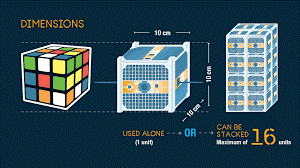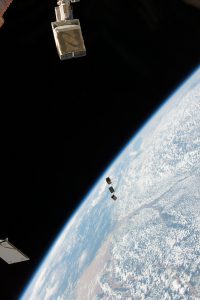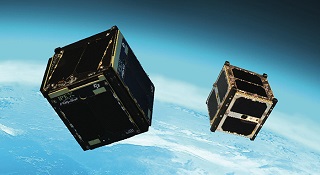[Editor’s Note: Multi-Domain Operations (MDO) describes how the U.S. Army, as part of the joint force, can counter and defeat a near-peer adversary capable of contesting the U.S. in all domains, in both competition and armed conflict. MDO provides commanders numerous options for executing simultaneous and sequential operations using surprise and the rapid and continuous integration of capabilities across all domains to present multiple dilemmas to an adversary in order to gain physical and psychological advantages and influence and control over the operational environment.
Today’s guest blog post by Mr. Matthew Ader, however, addresses the advent of inexpensive CubeSats, capable of providing global surveillance at a fraction of the cost of legacy spy satellites, and how they could usher in the end of covert movement for combat units and their associated logistical support, and with that the demise of strategic and operational deception and surprise.]
One of the key factors of war since time immemorial has been uncertainty. The dispositions of the enemy, the strength of their industry, the will of their people – all have been guessed at, but rarely known for certain. Thanks to a pair of companies in California, that is about to change. Deception is dying.
 Planet Labs operates a constellation of around 180 CubeSats – shoebox sized satellites in low earth orbit. Each day, they photograph the entirety of the globe, sending 6 terabytes of data to Earth for use. That capacity alone is valuable, but the sheer volume of data makes it impossible to analyze quickly.
Planet Labs operates a constellation of around 180 CubeSats – shoebox sized satellites in low earth orbit. Each day, they photograph the entirety of the globe, sending 6 terabytes of data to Earth for use. That capacity alone is valuable, but the sheer volume of data makes it impossible to analyze quickly.
For a human.
Artificial Intelligence (AI) image analysis is not so limited. This has been recognized and operationalized by Orbital Insight, a company specializing in AI image analysis. Partnering with Planet Labs, Orbital Insight delivers unique intelligence – for example, counting cars in parking lots to determine market movements. If they can count cars, they can certainly count tanks.
And, unlike conventional satellites, CubeSat imagery is cheap. It costs about US$100,000 to put one into orbit. The cost of a Planet Labs satellite is not easily available, but a similar sized CubeSat costs an estimated US$30,000. A 180-satellite constellation would therefore cost US$24.3 million, around a third of the price of a single F-35. If more timely imagery is required, buying more satellites is not an obstacle. It’s harder to find solid numbers for AI, but Project Maven, DoD’s flagship image analysis research program, was budgeted at $93 million a year.
 Therefore, it’s not implausible that given some years for technology to mature and a few billion dollars investment1, any national military will have the capability to persistently surveil the entire Earth. A combination of camouflage and low-resolution satellite cameras will probably preserve tactical deception. But strategic and operational deception, the covert movement of battalions and carrier strike groups, will be impossible. That is a revolution in military affairs.
Therefore, it’s not implausible that given some years for technology to mature and a few billion dollars investment1, any national military will have the capability to persistently surveil the entire Earth. A combination of camouflage and low-resolution satellite cameras will probably preserve tactical deception. But strategic and operational deception, the covert movement of battalions and carrier strike groups, will be impossible. That is a revolution in military affairs.
 In particular, logistics will become very difficult. The depots and truck convoys required to sustain a modern army will be easily visible. Long range, uninterceptable hypersonic weapons can then strike these targets with impunity. Even absent high-tech hypersonics, conventional missiles and rocket artillery can still have a serious impact. The result is that deploying and sustaining any sizeable force against an enemy with a large CubeSat constellation will be very difficult.
In particular, logistics will become very difficult. The depots and truck convoys required to sustain a modern army will be easily visible. Long range, uninterceptable hypersonic weapons can then strike these targets with impunity. Even absent high-tech hypersonics, conventional missiles and rocket artillery can still have a serious impact. The result is that deploying and sustaining any sizeable force against an enemy with a large CubeSat constellation will be very difficult.
 In trying to predict the future of war, it is easy to fall prey to LTG H.R. McMaster’s ‘vampire fallacy’ of thinking new technology will deliver bloodless, decisive victory. Certainly, there are a range of factors which could mitigate the incredible intelligence advantages of CubeSat constellations. These could range from better cyberwarfare to degrade enemy intelligence sharing, to more effective missile defense, to directly attacking the CubeSats themselves.
In trying to predict the future of war, it is easy to fall prey to LTG H.R. McMaster’s ‘vampire fallacy’ of thinking new technology will deliver bloodless, decisive victory. Certainly, there are a range of factors which could mitigate the incredible intelligence advantages of CubeSat constellations. These could range from better cyberwarfare to degrade enemy intelligence sharing, to more effective missile defense, to directly attacking the CubeSats themselves.
These mitigating factors do not occur in the wild. It will take years of hard work to develop and deploy them. The U.S. military, in partnership with its allies, must take the lead on developing its own CubeSat constellations and countermeasures. Because if they don’t, someone else will – and the results for U.S. power could be potentially catastrophic.
If you enjoyed reading this post, please also see our related discussions regarding Concealment in the Fundamental Questions Affecting Army Modernization post and Finders vs Hiders in our Timeless Competitions post…
… and our Star Wars 2050 post by Ms. Marie Murphy.
Mr. Matthew Ader is a first-year undergraduate reading War Studies at King’s College London.
1 Accounting for ground receiving stations, CubeSat replacements, additional staff and other associated costs.




As with all emerging technology there is a “magic bean” mentality with new toys, Cubesats are just such an example. Believe me I have seen this first hand. They are significantly constrained by a number of factors, included but not limited to sensor capability, orbital threats and counter-space capabilities.
The imagery sensors aboard a tactically responsive platform are significantly less capable than their bigger cousins, and unless the constellation is significantly robust there will be periods where persistent coverage is not physically possible. I agree that large concentrations of surface combatants are vulnerable to detection, but I would argue that any current near-peer competitor or motivated individual can already determine where a carrier strike group will be headed based upon less technical and far-less expensive means than a couple dozen cubesats.
At current it is possible to track any object placed into orbit from commercially available space situational awareness websites, making these sensors highly vulnerable to counter-space assets that range from temporarily dazzling, downlink jamming all the way to a kinetic kill. Essentially they are eyes and like any eyes they can be poked out because they are not large enough to carry the countermeasures needed to make them survivable in a space war.
In short, should we find ourselves at war, the utility of small, rapidly deployed imagery satellites is another perceived silver bullet that does not necessarily meet with current expectations or the promises of our military space contractors.
The following comment was received from Mr. Fred Brosk and is posted here with his permission:
“I was very interested in the guest blog 115 by Mr. Matthew Ader on War Laid Bare and his point that operational and strategic deception will become a thing of the past with the advent of inexpensive Cubesats.
Of course, he is incorrect in this assertion and I recommend he review Thaddeus Holt’s first six chapters in the book “The Deceivers” and Barton Whaley’s dilemma of deception in his book “Stratagem” (the decision maker has options for action based upon his assessment of the information).
Deception success is in the mind of the deceived, and knowing how that target “sees” processes, and acts upon information is key – and manipulation of Cubesats, even if they were to take multi-spectrum imagery, would be relatively easy with the use of high fidelity decoys.
As warfighters, if we count out the use of deception in the future then we will become even more susceptible to it to our great disadvantage.”